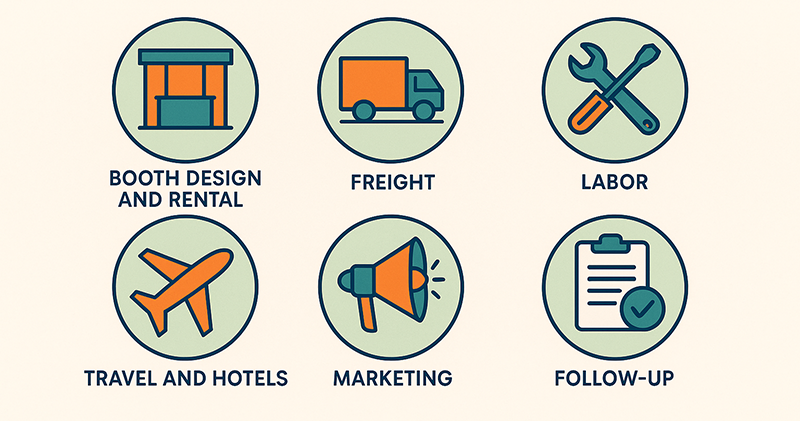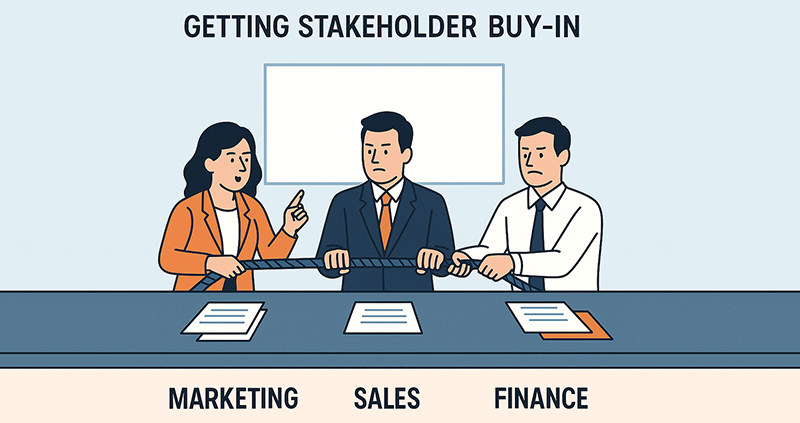How to Budget Properly for a Trade Show

Most exhibitors think they know their budget. Then the hidden fees, tired staff, and weak follow-up chew through their ROI.
A proper budget isn’t just a number on a spreadsheet. It’s a plan for the whole trade show cycle, from choosing the right event to the thank-you note that lands weeks later.
You thought the booth would cost $20,000. By the time the drayage bill landed and the staff per diem receipts piled up, it felt closer to $50,000. Sound familiar?
So how do you budget the right way? Let’s break it down with examples and real-world advice.
Beyond Booth Space: Where Budgets Really Go
Booth space is only one line on the invoice. If that’s all you’re tracking, you’re missing the bigger picture.
Major cost buckets usually include:
- Booth design and rental – structure, graphics, flooring, furniture
- Freight – getting your booth to the hall and moving it inside
- Labor – union crews, setup, tear down, and overtime charges
- Travel and hotels – flights, rooms, meals, transportation
- Marketing – pre-show campaigns, giveaways, interactive demos
- Follow-up – post-show thank-yous, lead nurturing, retargeting

Sneaky costs often missed:
- Drayage that costs more than your car payment
- Overtime labor because the carpet arrived late
- Electrical charges that double if you plug in one more monitor
- Late order fees because you waited too long to ship graphics
“Most exhibitors come with a budget, but they’re not thinking about all the factors… travel, gifts, incentives, staffing changes. Those things add up.”
Reality check: One exhibitor spent $12,000 just to have their crates moved from the loading dock to their booth space. That wasn’t on their spreadsheet.
When’s the last time you actually read last year’s invoices line by line? They usually tell the real story of what you spent.
Picking the Right Shows Before You Pick a Number
Budgeting is not just about how much you’ll spend. It’s about where you’ll spend it.
Some shows pull the right audience. Others drain your wallet without delivering any prospects. Consider attendee quality, whether your competitors will be attending, and how the show aligns with your sales cycle.
Would one high-impact show deliver more than three average ones? Sometimes the smarter move is fewer shows, better executed.
“Seventy-five percent of attendees already have a list of who they want to see when they walk in. The odds are you’re not on it unless you’ve been marketing for months.”
Case in point: A mid-sized exhibitor dropped $80,000 at a show with 20,000 attendees and came home with only a handful of qualified leads. The next year, they spent half that amount at a smaller regional show and landed three major accounts.
Build a Multi-Year Budget, Not a One-Off Spend
Veterans play the long game. They don’t budget one show at a time. They look at two to three years and plan for scaling.
Why it matters:
- Rental booths keep you flexible. You avoid storage, shipping, and repair costs.
- Owned booths can amortize over time, but tie you to one design and ongoing storage.
- Graphics and messaging fade and change every few years.
Rental vs. Custom comparison:
- Rental booth: about $40,000 per show, minimal add-ons, roughly $120,000 over three years. Very flexible.
- Custom booth: about $120,000 upfront, plus $35,000 or more each year in storage and shipping. Well over $225,000 in three years. Much less flexible.
“Challenge yourself to look beyond last year. Did you get the results you wanted? If not, what do you need to add—staff, incentives, or in-booth events?”
Risk and Contingency Planning
Trade shows are unpredictable. You don’t want one shipping delay to eat up half your budget.
Common risks worth planning for:
- Crates stuck in transit
- Weather delays that ground staff
- An illness that sidelines your top salesperson
- Graphics delivered misprinted
- Union crews charging premium rates when things go wrong
The smart move is to build in a 10 to 20 percent buffer. That cushion keeps you from panic-spending when disaster strikes.
“We’ve seen booths open half-finished because the setup crew was stretched too thin and graphics arrived late.”
Ask yourself: what’s the worst-case scenario, and how much would it cost to fix it fast?
Data-Driven Budgeting
Budgeting by guesswork is how exhibitors get burned. Use data instead.
Metrics worth tracking:
- Cost per lead – total spend divided by number of leads captured
- Cost per square foot – useful for comparing show performance
- Staff productivity – leads per staff member per day
Staff productivity is one of the most telling numbers. Who excelled and why? Was it product knowledge, a better opening question, or just more energy on day two than anyone else had left? Tracking this helps you see which team members create value and which ones may need training.
“If you’re not measuring ROI at 3, 6, 9, and 12 months, you’ll miss the true value of a show. These events drive pipeline, not just immediate sales.”
How to connect dollars to outcomes:
- Add a “How did you hear about us?” field to every form
- Tag every trade show lead in your CRM
- Track meetings scheduled before, during, and after the show
Budget isn’t just numbers. It’s a feedback loop for smarter decisions next year.
Getting Stakeholder Buy-In

Budgets collapse when leadership can’t agree. Marketing wants awareness, sales wants leads, and finance wants savings.
How to fix it:
- Align every line item to an outcome executives care about
- Translate costs into business terms (pipeline growth, customer retention, lead quality)
- Present the booth not as an expense, but as a sales channel
Mini dialogue:
- Finance: “This line item looks high.”
- Sales: “That’s our top client dinner.”
- Marketing: “And the only reason they remembered us the next year.”
Does your CFO see the booth as an expense or as a sales channel? That answer will decide how much budget you actually get.
Negotiation and Vendor Strategy
Trade shows are expensive, but not every dollar is set in stone.
Tips for stretching your budget:
- Book early – labor, freight, and booth services often have early-bird discounts
- Bundle services – using one partner for design, shipping, and installation reduces piecemeal costs
- Stay loyal – vendors often reward consistent clients with better rates or priority support
One exhibitor who waited until three weeks before the show paid 25% more in shipping alone. Another who booked the same vendor across three shows saved 15%, which they rolled into a bigger giveaway budget.
Future-Proofing the Budget
Costs aren’t static. Inflation, rising labor rates, and supply chain delays are affecting trade shows, just like everything else.
Ways to future-proof:
- Lock in vendor contracts early
- Add escalation clauses for long-term commitments
- Explore automation tools for lead capture, scheduling, and logistics
“The days of freestyling a show are over. You need a plan, because costs rise every year and attendees are already making lists of who to see.”
If costs go up another 10% next year, what will you do?
Think of your budget as a living playbook. It should adapt as the market shifts.
Final Thoughts
A trade show budget isn’t just accounting. It’s your game plan for growth.
The booth is your stage, but the budget is the script. Write it well, and the performance will shine.
When you plan the next one, ask yourself: Are you funding a booth, or are you building a growth engine?
If you want to create a budget strategy that works across shows and years, give us a call at 702-661-4194 or email info@tradeshowdisplays.com. We’ll help you plan smarter, avoid surprises, and get the ROI you came for.

